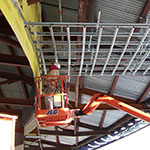In the past 50 years, Las Vegas has played host to some of the largest construction projects in the world, reveling in its adult-playground reputation and widespread popularity. Then, in 2009, everything changed.
“We saw construction firms that in the past wouldn’t move a muscle for contracts under $10 million now competing for contracts under $100,000,” says Josh Hainsworth, vice president of Mountain Vista Development, Inc. The city watched development come to a halt seemingly at once. Homebuilders and contractors lost almost all their work and turned to commercial and government jobs, but then those projects dried up as well. This created aggressive competition for the small amount of work that was still available, and prices dropped drastically. Small margins led companies to close their doors or leave the state, and that, in turn, gave rise to another wave of competition as many contractors and subcontractors started working for themselves. It was the only way they could afford to work for the small margins the market would allow.
“The downturn of the economy hit us hard and fast,” Hainsworth says. “We were forced to reduce our overhead, including downsizing employees and internal systems and services that were no longer cost-effective.” Such measures, though, allowed Mountain Vista to compete at very low margins, and though those margins didn’t translate to profitability, they allowed the firm to keep its doors open and focus on new areas, including government work.

“We started to focus on where government funding was being spent and found that there were sizable allocations being made for projects that allowed for energy-efficiency retrofits and new green building,” Hainsworth says. “We put a lot of our energy into competing for these contracts and were successful.”
Using this approach, the firm won a competitive-bid process to refurbish two buildings for the Seigle Diagnostic Center, where students of the Clark County School District obtain evaluations for speech impairment, hearing problems, traumatic brain injury, and associated maladies. The $4.5 million project involved the renovation of 40,000 square feet of interior offices, including a complete interior demolition and build-out, and, outside, refurbishment of the landscaping and the asphalt parking lot. “The plans started with ambiguity, so we worked to create solutions from the start rather than wait for change orders to occur,” Hainsworth says. The revamped facility opened in 2010.
As that project was winding down, Mountain Vista also completed seven concurrent projects for the Caliente Youth Center in accordance with its contract with the Nevada State Public Works Board (NSPWB). Per the contract, the firm was to provide design assistance, value-engineering proposals, and complex budgeting and scheduling options in order to calculate the most cost-efficient way to complete all seven projects. The first phase involved improvements to four dormitories and the surrounding site; the second phase entailed the demolishing and rebuilding of a swimming pool with new concrete, reinforcing plaster, deck finishes, and equipment and connections for a solar heating system; and the third phase called for the construction of a 2,000-square-foot recreation building. With Mountain Vista’s help, the NSPWB saved more than $400,000 in construction costs on the $4.5 million project.
Such work kept the firm in business, and by early 2013, the downturn had thinned its herd of competitors. “The amount of work wasn’t increasing, but for those of us lucky enough to still be in business, chances were starting to get better for being awarded new work,” Hainsworth says.

“For those of us lucky enough to still be in business, chances [are] starting to get better for being awarded new work.”
—Josh Hainsworth, VP
He also started seeing an increase in the number of property owners feeling out the market for new projects, and by early 2014, work began to steadily pick up for the first time in more than five years. “Now we are nearing the end of the second quarter of 2014 and are still seeing the same levels of growth,” Hainsworth says. “We’ve been inundated with calls for new projects and requests for proposals across the board; from commercial, residential, and government contracts, the potential projects are everywhere.”

Because of the firm’s initial downsizing, however, it’s conservative when it comes to increasing spending and allocating resources to obtain this new work. “Our idea is to grow slowly but steadily back to a level where we are comfortable operating,” Hainsworth says. “We hope that by the end of 2015, we will be back to where we want to be.”


